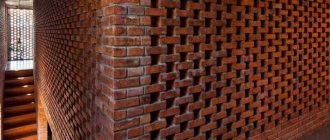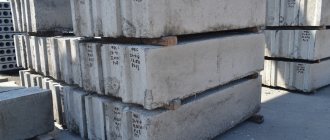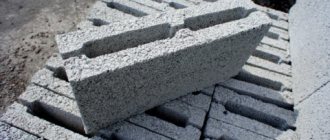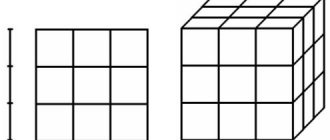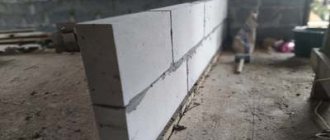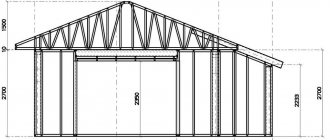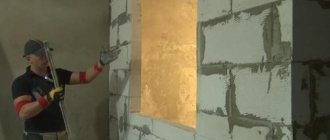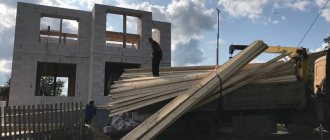To choose the thickness of an aerated concrete partition, you first need to understand the following questions: what level of sound insulation is required and what objects will be hung on this partition.
Let's start with the fact that partition gas blocks come in the following thicknesses: 50, 75, 100, 125, 150, 175, 200 mm. The most optimal and common are blocks with a thickness of 100 to 175 mm, as they have good strength and average sound insulation.
Remember that there are partition blocks of increased height on sale, up to 500 mm, which will significantly increase the speed of masonry compared to the standard 250 mm.
You can get acquainted with the various options and current prices for aerated concrete blocks here - https://buildstock.ru/products/gazobetonnye-bloki/
Weight and strength of foam block
Two material parameters that are directly related to each other are weight and density. The partition block is divided into six gradations of strength, corresponding to a certain density and weight, which are marked in the documentation with the Latin letter “B” and numbers from 1.5 to 4.
The density of the partition foam block can vary from 300 to 1200 kg/m 3, which affects its weight and structural properties. As a rule, blocks with a density from 300 to 500 kg/m 3 are called thermal insulation and are used for thermal insulation of load-bearing walls. A block with a density of 600 to 900 kg/m 3 is called structural-thermal insulating and is most often used in the construction of partitions, which is very clearly visible in the photo of the corner sections of the wall, when the ends of the blocks in the masonry are clearly visible.
Installation of foam block partitions
To install partition blocks, it is necessary to perform some preparatory operations, on which the quality of the future wall will depend:
- Buy high-quality glue for foam concrete, because laying blocks on a simple cement-sand mortar is not recommended;
- Prepare the necessary tools;
- Mark the position of the future wall. It is better to do this using a laser construction level;
- Watch the training video, which shows in detail the sequence of operations for laying the partition foam block.
Having felt confident in your own abilities and having looked at the work of the craftsmen, you can slowly install the partition block on your own, since the properties of the material allow you to easily perform all operations without resorting to outside help. Having evenly applied a thin, no more than 5 mm, layer of special glue, we stack the blocks on top of each other, observing the bandaging of the seams, not forgetting about the reinforcing reinforcement and be sure to control the quality of the masonry using a building level or plumb line. “Having laid the last row of blocks, we get a high-quality partition with a smooth, rough surface, ready for applying a small layer of finishing materials.
The modern housing stock for new residents provides a huge field of activity, since sometimes there is nothing in the new apartment except the main walls. Therefore, happy buyers of a new home have to carry out all the interior decoration themselves, including the construction of interior partitions.
Until recently, ordinary brick or plasterboard (a two-meter sheet of durable cardboard with gypsum filling) was widely used to construct partitions. But brick is too heavy a building material, and delivering it to multi-story buildings without a freight elevator is difficult. And drywall does not have great strength and good sound insulation.
Features of the construction of the partition
When constructing internal walls, it is necessary to control their evenness using a building level.
At the site where the first layer of aerated concrete blocks will be laid, a strip of material intended for sound insulation is glued. The first level of the partition is “planted” on it. It is necessary to ensure even laying and regularly check the masonry using a building level. The fewer defects on the surface of the finished inner wall, the less finishing material will be required in the future.
When laying a wall, it is necessary to provide excellent ventilation in the room. This will reduce drying time.
In addition, you need to constantly monitor the correct placement of gas blocks during construction. The rows of the inner wall must be laid strictly perpendicular to the load-bearing wall. In one horizontal row, the elements are separated from each other using vertical mortar joints. The next row should be placed so that the middle of each new product overlaps the vertical seam of the bottom row. This installation option makes it possible to more evenly distribute the load, as well as significantly increase the structure’s resistance to settlement.
For interior or interior systems, you need to choose high grade cement. A solution made from higher quality raw materials has much better strength indicators.
The surface of the products that will come into direct contact with the solution must be moistened with water. This will prevent the gas blocks from being saturated with water from the solution. Otherwise, the solution will crack from lack of water, and the elements will lose their strength and stability.
If the planned structure exceeds 5 m in height, then a reinforcing mesh must be applied to it. It will make the constructed wall more stable and durable.
When building interior systems in the third way, that is, perpendicular to the load-bearing wall (almost touching it), the junction of the load-bearing wall and the partition needs to be strengthened. As a rule, this joint is filled with polyurethane foam or glued with the material used to create sound insulation. In some cases, special anchors are used to create greater stability. These elements are fastened deep into the load-bearing wall, thus providing the necessary strength to the block partitions.
Partitions are made from aerated concrete blocks, as a rule, after the construction of load-bearing walls, as well as after the construction of the ceiling. If there is no floor on the ground floor in a private house, then it needs to be made. That is, fill in the rough screed.
Partitions are made from aerated concrete with a density of 500 kg/m3 and a thickness of 10-20 cm. But in most cases, partitions are made from aerated concrete blocks 10 cm thick, such as those described in this article. Blocks made from this material have a number of advantages
, these are like:
Light weight, ideal geometry, low glue consumption, good sound insulation, good thermal insulation properties (although this does not matter for partitions), fire resistance, non-toxic, easy to install.
And there are requirements for partitions:
— The height of the partition should not exceed 3.5 m and the length 8.5 m.
Types of foam blocks: their sizes and thickness
you need to understand the types of foam blocks
In addition to the density, this material also differs in the manufacturing method. There are autoclave and non-autoclave methods. The latter is more often used by small enterprises that do not have good quality due to poorly established technical control.
The non-autoclave manufacturing method creates uneven porosity of the material. As a result, a partition made of such blocks shrinks by about 3 millimeters on a section of the wall 1 meter high. Therefore, a partition made of foam blocks made by autoclave will be much stronger.
This material also differs in the stamping method; it can be cutting or forming blocks. In the first case, blocks are cut from foam concrete with a special circular saw. The result of this manufacturing method is geometric evenness of the edges and perfectly matching block sizes.
With the molding manufacturing method, liquid foam concrete hardens in special forms. Although all forms are standard sizes, block sizes may vary. This is the minus of molding.
Separately, it is worth highlighting the issue of the size of foam blocks for partitions. Typically, blocks with the following parameters are used for the construction of interior partitions:
- different thicknesses: 50, 75, 100 or 150 mm;
- height and length - standard 300 mm x 600 mm;
- weight depends on thickness and density 5.5 kg - 16.2 kg;
- optimal density D600.
Foam blocks with such parameters are suitable for partitions of any height.
Requirements for a gas block partition
Aerated concrete partitions must be characterized by certain features. Firstly, the design should be quite durable. Secondly, you need to build a wall that will well soundproof adjacent spaces. Thirdly, the wall must be safe in terms of fire resistance.
If the partition will have to separate rooms with different temperature conditions, it will be required to isolate one room from another so that you can live comfortably in the house. If you carry out the correct finishing, adding a layer of insulation, the wall will meet all these requirements, and in addition, it will be inexpensive.
Optimal dimensions of aerated concrete partitions
The dimensions of the aerated concrete blocks determine the dimensions of the partition. Today time is especially valuable. If you want to complete renovation or construction in a short period, it is better to use large-sized products, the length and width of which are 750 x 625 mm, respectively. The thickness can be 75 or 100 mm. This block format allows you to reduce glue consumption, speed up work and ensure ease of installation due to their low weight, which does not exceed 32 kg.
If the gas block will be used to construct a self-supporting partition, class B2.5 products should be used. This recommendation is true for walls more than 3 floors high. If this value is lower, the block strength should be B2. To build a standard partition from aerated concrete, products with a size of 30 cm are used. If it is necessary to separate one room from another, blocks with a width of 15 cm should be used. The density here should be D300, since the issue of sound insulation in this case is very important.
More about sizes
The dimensions of the gas block are one of the important factors when choosing this material. Modern manufacturers produce products with thicknesses from 75 mm to 200 mm. These sizes are suitable for interior partitions, but the most common dimensions are blocks of 625 x 100 x 250 mm. Experts do not recommend using 75 mm blocks for long walls, as they become loud and make living inside the house uncomfortable.
What is the standard foam block size?
There are two ways to make foam blocks of the required size, either by cutting a solid slab of foam concrete, or by pouring it into molds. Accordingly, the size of the foam block for construction varies. When choosing, you need to know several nuances. For example, it is unprofitable to use elements that are too large and massive. In this case, the speed of construction is reduced, and creating a foundation with a grillage will require a lot of money.
Due to the fact that there is a standard foam block size, you can choose the best option for construction. Here is a list of the most commonly used standard product dimensions in mm:
- 400x200x600 – used for external load-bearing walls.
- 200x300x600 – for internal carriers.
- 100x300x600 – for interior partitions.
But this is not all the dimensions. There are other options in GOST standards, which range from 90x250x600 to 200x200x400. The dimensions and weight of the D600 foam blocks most used in the construction of houses are presented in the table below.
| Length, mm | Height, mm | Width, mm | Quantity per 1m³ pcs. | Blocks on a pallet, pcs. | Weight of 1 block, kg |
| 600 | 300 | 100 | 55,56 | 80 | 10,8 |
| 600 | 300 | 120 | 46,3 | 64 | 12,9 |
| 600 | 300 | 150 | 37,04 | 48 | 16,2 |
| 600 | 300 | 200 | 27,78 | 40 | 21,6 |
| 600 | 200 | 400 | 20,83 | 30 | 28,8 |
| 600 | 300 | 250 | 22,22 | 32 | 27 |
Optimal dimensions of blocks for load-bearing walls
Standard sizes of foam blocks for load-bearing walls:
Using foam blocks for external walls is an excellent option to save on heating costs and make a durable structure.
Selecting a block for partitions
The peculiarity of the interior partition is that it is not under such a high load. In addition, it does not need high heat resistance. This means that the dimensions of foam blocks for partitions can be smaller. The optimal option is 100x300x600. Is it possible to use smaller blocks? No. The strength of the structure will be insufficient. Reducing the internal walls is not recommended because products of 5 cm or 8 cm will be too fragile. It will be difficult to make a flat wall, and leaning on the wall or hanging interior decor will be scary.
But if you use a partition block larger than 100 mm, then it will be unprofitable in economic terms. A wall of 10 cm is enough to provide high sound insulation qualities. Yes, and you can hang pictures, shelves and other decorative elements on it. If you choose a block width larger than the standard one, the usable area of the rooms will decrease.
What size to use for interior load-bearing walls
As for the walls inside, which are load-bearing, their thickness increases. After all, they carry heavy loads. This means that the optimal dimensions will be 300x200x600. Some make the walls even 40 cm thick. However, since the wall is located indoors and will only bear the load of the structure, its thermal insulation qualities are not so necessary. That is why the optimal size of foam blocks for building a house is 300 mm.
Thickness of aerated concrete partitions
For the construction of partitions indoors, special gas silicate blocks are produced that have a smaller thickness. The standard thickness of partition blocks is 100-150 mm. You can find non-standard ones in 75 mm and 175 mm. The width and height remain standard:
- width 600 mm and 625 mm;
- height 200 mm, 250 mm, 300 mm.
The grade of aerated concrete blocks must be at least D 400. This is the minimum density that can be used for the construction of partitions up to 3 meters high. Optimal - D500. You can also take denser ones - grade D 600, but their cost will be higher, but they have better load-bearing capacity: you can hang objects on the wall using special anchors.
Without experience, it is almost impossible to determine the brand of aerated concrete. You can “by eye” see the difference in density between the thermal insulation blocks. D300 and wall D600, but between 500 and 600 it’s difficult to catch.
The lower the density, the larger the “bubbles”
The only available control method is weighing. Data on the dimensions, volume and weight of partition blocks made of aerated concrete are given in the table.
Parameters of aerated concrete blocks for partitions
The thickness of aerated concrete partitions is selected based on several factors. The first is whether it is a load-bearing wall or not. If the wall is load-bearing, in an amicable way, a load-bearing capacity calculation is required. In reality, they are made the same width as the external load-bearing walls. Basically - from wall blocks 200 mm wide with reinforcement in 3-4 rows, like external walls. If the partition is not load-bearing, use the second parameter: height.
- For a height of up to 3 meters, blocks 100 mm wide are used;
- from 3 m to 5 m - the block thickness is already taken to be 200 mm.
You can more accurately select the thickness of the block using the table. It takes into account such factors as the presence of a connection with the upper floor and the length of the partition.
Choosing the thickness of a partition made of aerated concrete blocks
Tools and materials used for laying foam blocks
Before starting work on constructing a partition from foam blocks, you need to prepare a set of necessary materials and tools:
- glue for foam blocks at the rate of 15 kg per 1 cubic meter. meter (with a layer of 2 mm);
- cement mortar for laying the bottom row;
- mounting foam for foaming the gap between the top row and the ceiling;
- foam gun;
- pins - self-tapping screws, metal embedded pins;
- spatulas and trowel;
- a drill with a mixer for mixing glue and cement mortar, a container for glue;
- a hammer with a rubber pad for leveling blocks when laying;
- construction laser or regular level;
- corner, wood hacksaw for sawing blocks;
- a plane or grater for foam blocks to level the surface before finishing;
- electric milling cutter or wall chaser for making holes and grooves in the partition;
- a large brush for sweeping away concrete dust from rows before applying glue.
After preparing everything necessary for the construction of a wall partition made of foam blocks, you can proceed directly to the beginning of work.
And here is an article about laying cork flooring.
Covering openings
Overlapping methods are determined by the width of the arch. When its dimensions are within 0.8 m, you can use blocks 60 cm long (with a width of 100 mm, their weight is 11 kg) without jumpers. A temporary supporting frame is placed in the opening, two stones are installed with glued ends end to end in the middle of the arch. Next, the next rows of gas blocks are laid out. Longer openings are covered with lintels (prefabricated, monolithic, metal, wooden).
For a prefabricated structure, 50-centimeter U-shaped gas blocks, hollow inside, can be used (permanent formwork). Such elements are also placed on a temporary frame, the ends are covered with glue and compressed. A hollow tray formed by several stones houses a volumetric reinforcement structure, which is completely filled with compacted concrete. The solution is leveled along the upper level of the masonry. After the concrete gains strength, the stone support is removed.
Return to contents
Do-it-yourself installation of partitions
The construction of high-quality partitions from foam blocks is accessible to any person capable of working with construction tools. No special knowledge or skills are required here, the main thing is to follow construction technology.
What is required for construction
All the tools for creating a partition from foam blocks are usually found in a workshop, garage or storage room. There is no need to buy special equipment. You will need:
- safety glasses, gloves and a respirator (when cutting, foam concrete generates dust);
- spatulas and trowel;
- mixer and glue container;
- drill;
- mallet;
- gun for construction foam;
- level;
- hacksaw;
- plane or grater for foam blocks;
- wall chaser;
- wide brush.
The materials you will need are the blocks themselves, an adhesive, a cement-sand mixture for the cushion under the bottom row (if necessary), construction foam, reinforcing bars and mesh, and self-tapping screws.
Preparing to lay the wall
The installation of partitions from foam blocks begins with creating a diagram of the future structure according to the apartment plan. It is necessary to measure the room and draw the partition element to scale
This is important for calculating the number of blocks and binder composition. If the glue layer is supposed to be about 2 mm, then 15 kg of it will be required per cubic meter of blocks
In this case, the location of window and door openings or arches should be taken into account
So, when the door is located at an angle, it is important that there is a distance to the wall for the platband and ease of installation - at least 10 cm
Before you start laying interior partitions from foam blocks, thoroughly clean and prime the base, and then apply basting lines on the floor and walls. To ensure that the block structure is perfectly level, install temporary beacons along the marking lines. For this you can use wooden slats or metal profiles.
Clean the blocks themselves from dust, cut them into the required pieces with a hacksaw and moisten them with water to make the masonry dense. Dilute the glue to the thickness of rich sour cream.
Types of reinforcement
The block design with a small thickness is quite high. When laying, you will need to reinforce the wall. How to do it? Interior partitions of this type require three types of reinforcement:
| Type of bundle | Technology | Frequency |
| With walls | Before installation begins, metal pins are driven into the walls adjacent to the partition or reinforcing bars are inserted into pre-drilled holes (5 cm). Holes are cut out in the blocks for mounting on these pins, or the reinforcement is positioned so that the block elements are laid on the protruding ends. | Every 2-3 rows. |
| Between partitions | Required when laying several partitions connected to each other for bonding strength. | Depending on the project. |
| In the masonry itself | Reinforcing mesh or rods are laid between the rows. | In the top three and bottom three rows. |
If the structure is created in a room with high ceilings, reinforcement will also be required in the middle part.
Laying a partition: step-by-step instructions
The first row of blocks is placed on a thin cushion of cement-sand mortar, if there is concrete underneath. But you can mount the structure on an already finished floor.
But in any case, the base must be extremely level.
Further installation of partitions with your own hands from foam blocks is not difficult:
- The second and every even row begins with half a block - the laying is done in a checkerboard pattern. Before laying out the adhesive composition, the surface of the blocks is leveled with a grater or plane and swept with a brush. You can give each block an even position by gently tapping it with a mallet.
- If a door or window opening is intended, it must be reinforced with a special lintel. A similar metal structure can be purchased at a hardware store. Or they create a temporary wooden frame on which blocks cut in the shape of the letter “L” are installed. It is secured with self-tapping screws and removed after the masonry has dried. Then a permanent jumper of two reinforcing bars is installed. They are inserted into cavities sawn in the upper corners with a length of 5 to 10 cm and a height of 2 cm. The reinforcement is fixed with mounting wedges and glue.
- When creating a partition from foam blocks with your own hands in an apartment, the masonry does not go all the way to the ceiling. It is necessary to leave a gap of 1.5 cm so that the partition does not deform due to ceiling vibration. After the solution dries, this distance is filled with foam.
The dismantling of the guide profiles is also carried out after the adhesive composition has completely hardened - after about two days.
The finished structure is primed, plastered and decorated. If tiling is planned, there is no need to plaster - glue and ceramics will provide sufficient protection from moisture.
Construction of openings and lintels
For doorways or arches in partitions in a house made of aerated concrete, prefabricated or monolithic lintels are used, which are made on site. For the installation of lintels, concrete products, steel profiles or wooden moldings are used. When installing a lintel made of U-blocks, reinforcement is first performed. To do this, reinforcement is placed inside the cutout and a cement-concrete mixture is poured. The result is a monolithic reinforced concrete structure.
Foam block and aerated concrete are not the same thing!
The base of aerated concrete blocks also contains sand, cement and water, but unlike foam blocks, lime is added to the mixture, which reacts with a suspension of aluminum powder to release hydrogen.
The presence of this gas in the raw mixture creates the porous structure of the material. The difference in the internal structure of a foam block and a gas block is visible to the naked eye and is easy to determine by touch: the latter has through porosity, which significantly reduces its moisture resistance.
Before it is fully ready, aerated concrete must also undergo heat treatment under pressure for 12 hours. Therefore, foam blocks are cheaper and, therefore, more economical in private housing construction.
Wood or foam block. What's better? You will find out the answer by reading this article.
And here is an article about building a garage from foam blocks.
Where are aerated concrete blocks sold?
Aerated concrete blocks from the manufacturer can be purchased from official dealers of manufacturing plants, and most often they are not stores, but production and construction companies or specialized bases of building materials.
Our base is the official dealer of the leading Russian company H+N. You can get acquainted with its products on the page Aerated concrete N+N. The main criterion that we followed when choosing a plant that supplies aerated concrete blocks to our warehouses was the feedback from our clients, including the largest developers in the North-West. Did you like the article? Tell us about it:
Size discrepancy
When choosing foam concrete blocks, it is worth considering the fact that their dimensions may not correspond to those declared by the manufacturer. Sometimes the spread of values in width, height and length can be several millimeters.
The greater the spread, the more glue will be lost during laying. In some cases, laying with glue is completely impossible. If there is a large difference in size, masonry can only be done using cement. The thicker the seams, the more cold will penetrate into the room, since the solution has poor thermal insulation properties.
The discrepancy in size can be determined by eye
In addition, when purchasing a material, you should check its strength. You can do this yourself - try grinding a small piece of block between your fingers into powder. If this happens, then the material is of poor quality.
Tips and tricks
If you decide to start building a house using popular foam concrete blocks, then you need to take into account not only their dimensional parameters and weight, but also some useful recommendations from experts:
It is necessary to transport foam concrete blocks only in a truck. It is not recommended to resort to self-pickup using a trailer, since this way you can spend a lot of money on gasoline - you simply won’t be able to take away many foam blocks in one “flight”. We recommend purchasing a cut foam block, which consists of individual cut elements made from foam concrete mass.
Molding blocks do not have the same precise and true dimensions, and their edges are usually very fragile. If you pay due attention to the heat resistance of walls, then you should purchase foam concrete marked D600. High-strength D1100 materials are purchased less frequently - they are more durable, but less heat-resistant.
When purchasing foam block materials, it is recommended to stock up on reinforcing inserts. Always pay attention to the color of the building material. The foam block should be painted light gray
Never buy a white or yellowish block. It is not recommended to purchase foam concrete blocks in the spring. They are often cheaper during this period of time. However, it is possible that you will be provided with last year’s materials, which all this time have been lying under a layer of dust in a warehouse or even in the open air. Such blocks are less strong and reliable.
- Despite the fact that the foam block is a material that does not require additional finishing, it is still recommended to cover it with special plaster on the inside or with a cement-sand mixture for external surfaces. The strength characteristics of unfinished blocks may be reduced after several autumn/spring months.
- Before purchasing foam concrete blocks, you should check their geometry. To do this, you need to put two foam blocks on top of each other and see if they match. Then these elements must be turned over and the location of the remaining surfaces compared.
Unload foam concrete blocks as carefully and carefully as possible
Otherwise, you risk seriously damaging them where the edges pass (these areas are especially vulnerable). When choosing a foam block for construction work, you need to pay special attention to its cells. Remember - they must be isolated (should not be connected to each other)
Otherwise, such building materials will actively absorb dampness and moisture, which will negatively affect their performance characteristics. Check the foam block for strength. To do this, just try to break off a piece from the edge with your hands. If you manage to do this, it means that the material is of low quality and is not worth buying. It is recommended to build houses or outbuildings from foam blocks in temperatures ranging from 5 to 25 degrees. If construction still takes place at sub-zero temperatures, it is recommended to use special anti-frost additives.
Many homeowners are wondering what materials are permissible to use for cladding foam blocks, other than the usual plaster or decorative facade mixtures. To do this, it is permissible to use special tiles or stone (both natural and artificial). If you have not yet completed all construction work, then you should not leave foam blocks in the open air on the street
It is advisable to cover them with plastic wrap to protect them from negative external factors. When laying interior partitions or load-bearing walls, it is very important to ensure that there are no voids between the individual foam blocks. All remaining seams must be sealed with special glue.
This way you can avoid the problem of heat loss in your home. Don't skimp on buying foam blocks. These materials are already cheap, and in pursuit of excessive savings you risk purchasing unreliable and too fragile materials.
See below for details.
Types of foam blocks, their sizes and thickness
Foam block can be classified according to several factors, namely:
- production method;
- sizes;
- purpose;
- density.
As for the dimensions, the length is a standard indicator and is 600 mm. The thickness varies from 100 to 400 mm, while the width ranges from 200 to 400 mm. It is the thickness of the block that will determine the thickness of the wall. Products with standard dimensions are a block of 600 x 300 x 200 mm. It replaces almost 19 bricks.
In order to build an interior partition, it is better to use 100 mm blocks, while the external walls, which are also called load-bearing walls, should have a thickness of 300 mm. Installation of thermal insulation is usually carried out in blocks with a thickness of 200 to 400 mm.
Non-autoclaved
Foam blocks for partitions can be non-autoclave. They are dried under natural conditions, when the air temperature is kept above + 10 ˚С. A non-autoclaved foam block can also be dried by heat and humidity treatment. In this case, the material is placed in a special chamber. This method of processing the future product is ideal for gaining strength.
Autoclaved
Such a partition foam block not only undergoes drying under pressure and temperature, but also has a slightly different ingredient composition. Instead of cement, sand is added here. The amount of the first component is reduced by almost half, which makes it possible to obtain more outstanding characteristics.
Technological processes during production proceed much faster. All particles are bonded together as tightly as possible, which makes it possible to obtain a material with high strength and minimal shrinkage.
Molding
At this stage of foam block manufacturing, molds are used that consist of a steel pallet covered with a 5 mm sheet. Sides are attached to the sides, which also serve as stiffeners. This part of the mold should have maximum thickness, because it is on this surface that the highest load is placed when pouring the mold. To secure the assembled form, there are eyelets along its edges.
At the molding stage, the foam concrete solution is poured into molds and left until it dries and gains strength. Products in finished form are removed from the molds - this is how formwork is removed.
cutting
A foam block can have an ideal surface if it was made using cutting technology. First, the material is poured into a mold and dried, resulting in a large mass that is released and sawn into individual blocks. As a result, it is possible to obtain products of specified sizes. As a result, it is possible to obtain blocks with ideal geometry, no chips or irregularities at the corners, as well as a clean surface of the products without lubrication.
Aerated concrete wall structures
Aerated concrete for external walls is produced in several types. Each of them differs in technical parameters and scope.
Types of blocks
The type of wall block can be determined by the marking, which indicates its specific density in kg/m3. The higher it is, the stronger the material, but the lower its energy efficiency. The lower, the higher the porosity and the lower the strength.
- D300 – D500 – heat-insulating types of blocks;
- D500 – D900 – structural and thermal insulation;
- D1000 – D1200 – structural.
The photo shows the difference between materials with different specific densities.
When choosing the type of material, it is necessary to take into account the purpose of the building and the type of walls. If for outbuildings the thermal insulation characteristics are not of great importance, then for residential buildings they are no less important than load-bearing ones. Therefore, during their construction, the construction of aerated concrete walls is usually carried out in D500 - D600 blocks.
Types of aerated concrete walls
One of the main tasks when designing such a house is determining the thickness of the walls and their design, taking into account heat conservation standards. Calculation of aerated concrete walls is made based on the thermal conductivity coefficient of the material and climatic conditions in your region.
There are several options for constructing external walls:
| Type of design | Description |
| Single layer | The single-layer structure consists of blocks plastered on the outside using reinforcing mesh. |
| The plaster layer is applied on top of the insulation attached to the walls. |
| Load-bearing walls consist of a series of aerated concrete blocks and bricks with a mandatory ventilation gap between them. |
| In this case, the insulation layer is covered with sheet facade materials along the sheathing. |
In the middle zone of our country, if aerated concrete is used in the construction of a house, a wall 40 cm thick and finished with plaster is a completely acceptable option. In colder regions, multilayer structures are built.
Sectional view of an aerated concrete wall: gas-filled pores are visible, thanks to which heat is retainedTypes of foam blocks: by size and thickness
There are varieties of materials for installing partitions. Choosing the right type will help make the wall strong enough, durable and well-insulated. They differ in density; denser options are used for load-bearing walls, and internal walls are made of looser material.
To select a material, it is worth clarifying the location of the partition.
If you plan to install it on a balcony, it is important to ensure the least weight of the structure. If you plan to install it in a room, you should consider the load and density of the blocks
For external walls, you should select elements with a grade of at least D300 or higher. Partitions can be constructed from foam blocks of strength D150-D300.
According to the manufacturing method, they are distinguished:
Non-autoclaved
Suitable for small organizations, as it is of low quality. There is practically no production control; the material hardens naturally. Foam concrete gains strength unevenly, which changes the porosity of the product. If you use non-autoclaved foam block for internal walls, there is a high risk of the structure shrinking from 1 m to 3 mm. As the height increases, the shrinkage ratio increases;
Autoclaved
It is a higher quality option for a partition; the structure will last longer and is less susceptible to shrinkage. According to the stamping method, blocks differ in:
Molding
The liquid composition of foam concrete is poured into special forms and the material is waited for the final hardening. A disadvantage of the technique is the likelihood of dimensions deviating from the standard dimensions. A molded foam block is not advisable when purchasing, but it costs slightly less;
cutting
During the manufacturing process, a special shape is cut out with a circular saw, the product acquires a perfectly flat surface.
After determining the type of material, you should select the size of the blocks. Installation of partitions made of foam blocks is often made from a material with the following characteristics:
- the thickness of the partitions made of foam blocks is selected from 5 to 15 cm;
- standard dimensions (HxD): 30x60 cm;
- weight: 5.5-16.2 kg, depends on the thickness and density of the block;
- Ideally, blocks with a density of D600 are chosen; they are able to withstand load-bearing loads and are suitable for fastening heavy equipment.
- The most commonly used foam blocks are 100 mm thick; this parameter is enough to create a fairly strong wall with high insulating qualities and fire resistance.
We use tongue-and-groove blocks for partitions
Blocks of a tongue-and-groove design are also widely used for the construction of partitions indoors. Structurally, the tongue-and-groove slab is a monolithic block in the shape of a parallelepiped. The end surfaces of the tongue-and-groove plate have protrusions and grooves of appropriate sizes.
Blocks for interior work made from gypsum have gained enormous popularity.
Various types of products are used:
- standard, intended for use in dry rooms with humidity levels up to 60%;
- moisture-resistant, intended for use in bathrooms and toilets, where the moisture concentration is more than 60%.
Tongue and tongue blocks also differ in design features:
- solid products have increased strength and allow you to securely fix furniture and attachments;
- Hollow slabs are almost as good as solid slabs in terms of strength, are lightweight and reduce the load on the foundation.
Tongue-and-groove blocks allow you to construct partitions of various designs:
- single, with reduced thickness and low weight;
- box-shaped, allowing you to place engineering communications inside.
Blocks have a number of advantages:
- reduced thermal conductivity. The material provides a high level of thermal insulation and allows you to save on heating costs;
- simplicity and speed of installation. Thanks to special protrusions and grooves, products of standard sizes can be quickly installed;
- ease of finishing. After installing the blocks, the surface does not need to be plastered. It should be primed, after which you can glue wallpaper or tiles.
In rooms where there is constantly high humidity, for example, in the bathroom, use a hollow tongue-and-groove comb
Other advantages include:
- environmental cleanliness;
- fire safety;
- vapor permeability;
- ease of processing;
- affordable price.
Disadvantages of blocks:
- impossibility of application for main walls and load-bearing partitions;
- violation of the integrity of tongue-and-groove blocks during shrinkage of the building.
Correct laying of the first row guarantees the stability of partitions made from tongue-and-groove blocks.
Design features and requirements
Before choosing blocks for partitions in an apartment, you should consider their design features and evaluate whether the products meet the requirements for interior walls. So, the material must be reliable and durable so that the structure has the appropriate characteristics and can be used for hanging heavy objects. In addition, the material must be safe and non-flammable. Its weight should not be large enough to prevent the need for a separate foundation or solid foundation.
Gas and foam concrete blocks meet these requirements. Tongue-and-groove blocks are also suitable for this, since they are moisture-resistant, durable, and their hollow version weighs 25% less than a solid one. Installation work is carried out quite quickly, since the products are of impressive size, and finishing work is simple, since the material has good geometry.
All of the listed solutions are also offered for sale in a convenient partition design, which means that the consumer does not have to look for information about what the regulatory requirements for wall thickness inside an apartment or house are.
Walls made of aerated concrete or gas silicate will retain heat the best, but at the same time, they will also be the least durable due to porosity. Although the brick block ensures the reliability of the structure, each square meter of masonry weighs 250 kg. Brick is generally capable of creating a serious load on floors. If a partition in an apartment is being erected for the purpose of sound insulation, foam and gas blocks will best cope with this task. This is due to the presence of a large number of air bubbles in their composition.
Is it worth purchasing glass blocks?
Interior glass partitions are distinguished not only by style and beauty, but also by the highest level of durability. Today these are the only blocks that, after installation, do not require decorative or other finishing at all. They are beautiful in themselves. The glass block includes 2 glass plates, they are hermetically connected to each other. The surface of the glass can be smooth, have external or internal relief. This allows you to purchase blocks of exactly the variation that is needed. The color of the material can be any. The shape is most often square, but today you can buy glass blocks for partitions of other types.
The peculiarity of using this material is that the interior partitions are translucent, but the possibility of peeking is limited. Among the advantages, it is necessary to note a high level of fire resistance, 100% moisture resistance of the block, and a high level of durability. Such a block is not easy to scratch; they rarely break. Temperature differences allowed when using such units are -50/+200°C.
Connection diagram of glass block sections.
Typically, a block whose dimensions are 80*190*190 mm, 80*240*240 mm can be used for work. The weight can vary from 2.2 kg to 4.2 kg, depending on the shape and size. There are special additional elements in the form of corner and half blocks, the dimensions of which are 80*190*90 mm. The use of such products is convenient for constructing partitions of unusual shapes, when processing corners, etc. Some manufacturers offer shaped products of unusual shapes: triangular, round. Their surface can be smooth or corrugated; the glass surfaces themselves are available matte or transparent. Therefore, it is easy to choose the material that best suits your needs.
The shape of the partition can be a standard straight one, but curved options are also used, which give the interior modernity and originality. Today, glass blocks are used for bathrooms, providing protection from prying eyes, allowing free penetration of light. By combining glass blocks, you can achieve an interesting and unusual play of light.
How are glass blocks laid?
The order of work will be as follows:
For laying glass blocks, special masonry mortars are used, which do not contain large particles of sand, so as not to damage the surface of the product and make it less attractive. The material must be installed using a special tile adhesive, which has the necessary adhesion and ensures the highest strength. Suitable adhesive for ceramic, porcelain stoneware, natural stone tiles
It is important to be extremely careful: all adhesive that gets onto the glass surface during work must be removed immediately after application, before it has time to set. The peculiarity of working with glass blocks for partitions is that the glue hardens slowly. It is necessary to carry out the work slowly, taking breaks so that the glue has the opportunity to set securely
In this case, even a high interior partition will be strong and durable. If this condition is not observed, then the wall may simply “float”, and this is fraught with its destruction. For seams, you need to use special liners that make the masonry more reliable. Usually these are metal rods that fit into the grooves of the blocks. After working with the blocks, you can start grouting the joints. For this purpose, use any colored grout that can be used for laying ceramic tiles. Experts advise purchasing grout of a different shade, in which case you get an unusual and attractive effect.
Interior partitions can be made from various materials. They use not only standard foam blocks and bricks, but beautiful and high-quality glass blocks. In any case, you must immediately take into account the characteristics of the material used and the installation technology. For example, the mortar for brick and foam block or gypsum material will be very different, as will the rules for installing the partition itself.
Source
What is a foam concrete block?
Foam block is a porous building material made from a mixture of cement, water with sand and a foaming agent. This is one of the varieties of cellular concrete (foam concrete). But unlike aerated concrete, which is similar in structure, voids in it are formed not due to chemical reactions inside the block during the hardening process, but due to the mixing of the concrete mixture with pre-prepared foam.
The foaming agent used is organic or synthetic. The first protein-based option is more expensive, but the block with it is more durable and environmentally friendly. Synthetics are cheap, but have a 4th class of danger
The foam blocks themselves are safe, but you have to be more careful when mixing the solution when working with the original mixture
Forms for pouring foam concrete mixture
This material for building houses is produced in two ways:
- By cutting a monolith of hardened foam concrete into “bricks” of the required size;
- Filling forms with the required dimensions in width, height and length.
The process of sawing an array of hardened foam concrete into blocks
To save on raw materials and increase the density of the blocks, ash, clay and other bulk fine-grained materials are often added to the mixture when mixing. On the one hand, this allows a significant reduction in cement consumption, and on the other hand, it leads to thickening of the interpore walls inside the foam block, making the product more durable. Moreover, the size of internal voids in this case decreases, increasing the thermal conductivity of the material.
Appearance
Gas block calculation online
Calculation of aerated concrete for a partition includes determining the area of the partition and the number of blocks that will be required for construction.
- The area of a rectangular partition is determined by the product of its length and height minus the area of the openings. If the partition has a complex shape, it is divided into simple geometric shapes to calculate the area of each of them, followed by addition.
- To determine the required number of blocks, you need to divide the wall area by the side surface area and add 5 pieces to take into account trimming in openings and corners.
Attention! The wall area and the surface area of one block in calculations must be reduced to one unit of measurement.

